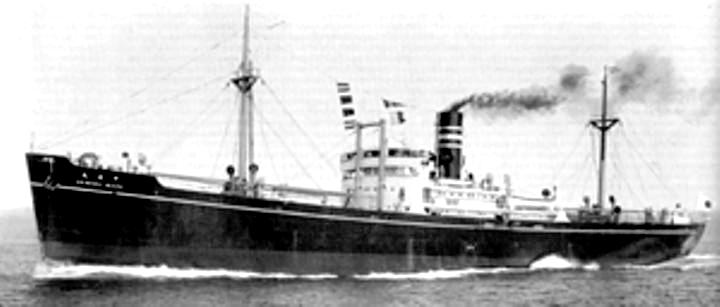
Tabular Record of Movement

© 2011-2018 Gilbert Casse, Bob Hackett and Peter Cundall
Revision 2
18 May 1935:
Launched and named SENKO MARU.
31 July 1935:
Completed and registered in Tokyo. Her registered net tonnage is 2,621-tons and her registered draft (light), 23.9’. Placed in Kinkai Yusen's Takao ~ Tokyo commercial service, transporting bananas and other fruits from Formosa to the Keihin (Tokyo – Kawasaki – Yokohama) area.
E 1936:
Registered net tonnage is changed to 2,618-tons.
E 1937:
Registered draft (light) is changed to 16.7’.
8 September 1939:
Her ownership changes to Nippon Yusen K.K.
16 August 1941:
SENKO MARU is scheduled to be requisitioned by the IJN under internal order No. 874.
21 August 1941:
Requisitioned by the IJN.
20 September 1941:
SENKO MARU is registered in the IJN as an auxiliary transport under internal order No. 1093 and attached to the Sasebo Naval District. Her homeport is Sasebo Naval Base. Enters Osaka Tekkosho (Ironworks) K.K., Innoshima shipyard to start her military conversion.
14 November 1941:
Conversion is completed. Attached to the Fifth Fleet as an auxiliary transport, (Ko) category. [1]
3 December 1941:
Departs Sasebo for Nagakasuku Wan (Bay), Okinawa.
The invasion units are embarked on 20 IJA transports: BENGAL, DAINICHI, DURBAN, KAIMEI, KAYO, KITANO, KOFUKU, LISBON, NAGATO, NICHIREN, RYOKA, RYUYO, SHINSEI, SHINSHU (4182 GRT), TAIAN, TATSUNO, TOFUKU, TOYAMA and TOYOHASHI MARUs and TAMON MARU No. 5.
The naval force consists of Vice Admiral (later Admiral) Kondo Nobutake's (35)(former CO of KONGO) Southern Force, Philippines Invasion Group that includes Vice Admiral Takahashi Ibo’s (35)(former CO of YAMASHIRO) Third Fleet. Rear Admiral (later Vice Admiral) Kubo Kyuji’s (38) (former CO of KAGA) Invasion Unit consists of his 1st Base Force HQ, in light cruiser NAGARA, 1st Quartermaster Ports and Docks Unit and 1st Naval Signal Unit, aboard HAKUSAN MARU, 1st Naval Guard Unit, aboard KIMISHIMA MARU, 1st Naval Survey Unit in SENKO MARU and Captain (later Vice Admiral) Mori Kunizo's (40)(former CO of SATA) Sasebo No. 1 and 2 Combined Special Naval Landing Force (SNLF) aboard MYOKO MARU.
The convoy’s escort consists of light cruiser NAGARA (F), heavy cruiser ASHIGARA, destroyers TOKITSUKAZE, YUKIKAZE, KAWAKAZE, SUSUKAZE, UMIKAZE, YAMAKAZE, minelayer AOTAKA, minesweepers W-7 and W-8, auxiliary gunboat/minelayer IKUSHIMA MARU, auxiliary gunboats BUSHO, KEIKO, KANKO and MYOKEN MARUs, auxiliary subchasers SHONAN MARU No. 17 and TAKUNAN MARU No. 5 and auxiliary netlayer FUKUEI MARU No. 15.
The Invasion Force departs Koniya, Amami Oshima for Lamon Bay, Quezon, Philippines.
24 December 1941:18 October 1943:
At 1000, departs Balikpapan for Palau in convoy No. 2609 also consisting of fleet oiler TSURUMI and KENZAN, DAI (ex-Dutch DUYMAER VAN TWIST) MARUs and OGURA MARU No. 2 (unconfirmed) and three other unidentified ships.
20 October 1943:
At 0800, DAI MARU breaks down and is assisted by auxiliary subchaser CHa-41.
21 October 1943:
At 1000, DAI and KENZAN MARUs and CHa-41 are detached for Menado.
25 October 1943:
The convoy arrives at Palau.
29 October 1943:
At 0600, departs Palau for Balikpapan via Menado, escorted by subchaser CH-4. Later CH-5 is scheduled to take over the escort.
E November 1943:
Arrives at Balikpapan, Borneo.
10 November 1943:
Departs Balikpapan for Padang escorted by minesweeper W-12.
E 12 November 1943:
W-12 hands over escort of SENKO MARU from Balikpapan to minesweeper W-8 at 04-00S, 112-00E. W-12 heads for Surabaya. SENKO MARU and W-8 proceed to Padang.
15 November 1943:
Runs aground at North Watcher Island, N of west end of Java.
17 November 1943:
Refloated by the 11th Special Construction Unit. South of the Sunda Straits exit, SENKO MARU is torpedoed and hit by an unidentified submarine. [3]
2 December 1943:
SENKO MARU is scheduled to depart Padang for Balikpapan with minesweeper W-8 as escort. On 30 November however, W 8 is recalled to Surabaya.
1 January 1944:
At 0600, SENKO MARU departs Balikpapan for Kupang, Borneo via Macassar.
1 February 1944:
Attached to Second Southern Expeditionary Fleet.
15 February 1944:
Departs Surabaya for Ambon.
20 February 1944:
Arrives at Ambon.
24 February 1944:
Departs Ambon for Macassar escorted by auxiliary subchaser TAKUNAN MARU No. 5.
26 February 1944:
TAKUNAN MARU No. 5 is detached off Wowoni Island.
28 February 1944:
Arrives at Macassar.
2 March 1944:
Departs Macassar for Surabaya.
5 March 1944:
Arrives at Surabaya.
23 March 1944:
At 1500, departs Surabaya for Laut island, S Borneo (now Kalimantan) in a convoy also consisting of IKUTAGAWA MARU (ex-Italian CALITEA II) with patrol boat PB-104 as escort.
24 March 1944:
The convoy arrives at Laut Island to load iron and coal. Then, SENKO MARU departs Laut Island and arrives the same day at Balikpapan, Borneo. Strikes a mine off the harbor.
25 March 1944:
Returns back to Balikpapan for temporary repairs.
13 April 1944:
Departs Balikpapan for Surabaya.
17 April 1944:
Arrives at Surabaya. Enters shipyard for permanent repairs.
31 July 1944:
Repairs are completed, undocked.
8 August 1944:
Departs Surabaya for Jakarta (ex-Batavia, renamed by the Japanese after its capture).
10 August 1944:
Arrives at Jakarta.
15 August 1944:
Departs Jakarta for Batam (Batang) Island, S of Singapore.
24-25 August 1944:
Boengos (Bungus) Bay, S of Padang, W Sumatra. Sustains aerials attacks from British carrier aircraft. SENKO MARU is hit by bombs in hold No. 3 and No. 10, near her engine room. Fires are brought under control by water, but damage is extensive and two Type-96 25mm AA guns, two 13mm and one 7.7mm AA gun are destroyed. Repairs are scheduled to be made at Surabaya shipyard.
23 July 1945:
Bombed in Boengos Bay. Engine room hit. Badly damaged and subsequently beached.
1 September 1945:
Towed to Emma Haven (now Teluk Bayur), Padang.
[3] No such attack is claimed by any Allied submarine.
Thanks go to Gengoro S. Toda of Japan and Berend van der Wal of Netherlands.
-Gilbert Casse, Bob Hackett and Peter Cundall

